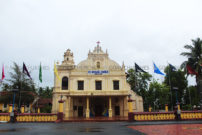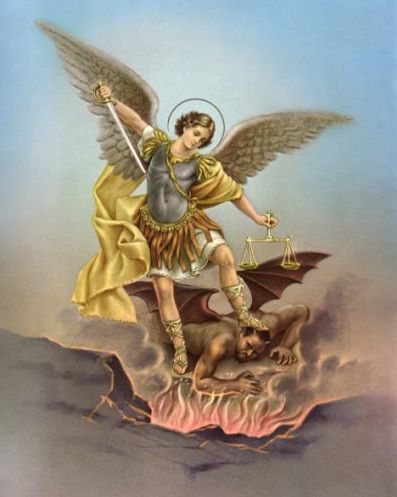
St. Michael the Archangel

St. Michael the Archangel is referred to in the Old Testament and has been part of Christian teachings since the earliest times. In Catholic writings and traditions St. Michael the Archangel acts as the defender of the Church, and chief opponent of Satan; and assists souls at the hour of death.
A widely used “Prayer to Saint Michael” was brought into official use by Pope Leo XIII in 1886 and was recommended by Pope John Paul II in 1994.
The Catechism of the Catholic Church states that: “The whole life of the church benefits from the mysterious and powerful help of the angels…. From its beginning until death, human life is surrounded by their watchful care and intercession.” In his 1986 address, “Angels Participate in the History of Salvation”, Pope John Paul II emphasized the role of the Archangels and stated that: “the angels who participate in the life of the Trinity in the light of glory are also called to play their part in the history of human salvation, in the moments established by divine Providence”.
Roman Catholic tradition calls Michael, Gabriel and Raphael archangels. Michael means “Who is like God?” (a rhetorical question), Gabriel means “Power of God” or “Strong One of God” and Raphael means “God has healed“.Michael, Gabriel, and Raphael are named in the Bible as angels. (Roman Catholics accept as canonical, the Book of Tobit, in which Raphael is named.) Only Michael is called an archangel in the Bible.
The feast of these angels is celebrated on September 29. An angel of supreme power and the leader of God’s army. Within the hierarchy of the angels, at the highest level, St. Michael is a princely seraph. The word archangel comes from the Greek words arche (prince) and angelos (messenger).
Christian art often portrays archangels together. Archangels Michael and Gabriel are jointly depicted on Our Lady of Perpetual Help, a Byzantine icon of the Blessed Virgin Mary that has been the subject of widespread Catholic devotions for centuries.
In Roman Catholicism St. Michael the Archangel has four distinct roles. First, he is the Enemy of Satan and the fallen angels. He defeated Satan and ejected him from Paradise and will achieve victory at the hour of the final battle with Satan. Secondly, he is the Christian angel of death: at the hour of death, Saint Michael descends and gives each soul the chance to redeem itself before passing. Saint Michael’s third role is weighing souls (hence the saint is often depicted holding scales) on Judgment Day. And finally, St. Michael the Archangel is the Guardian of the Church.
In the Catholic tradition, St. Michael the Archangel symbolizes the victory of good over evil, and he has been widely represented in Catholic art through the ages. Devotions to Saint Michael have a large Catholic following, and a number of churches are dedicated to him worldwide.
In Catholic teachings, St. Michael the Archangel is viewed as the leader of the Army of God. From the time of the apostles, he has been invoked and honored as the protector of the Church. Scripture describes him as “one of the chief princes” and the leader of heaven’s forces in their triumph over the powers of hell.
St. Michael the Archangel defeats Satan twice, first when he ejects Satan from Paradise, and then in the final battle of the end times. Noted hagiographer Alban Butler, defined the role of Saint Michael as follows
“Who is like God?” was the cry of St. Michael the Archangel when he smote the rebel Lucifer in the conflict of the heavenly hosts. And when Antichrist shall have set up his kingdom on earth, it is St Michael who will unfurl once more the standard of the cross, sound the last trumpet, bind together the false prophet and the beast and hurl them for all eternity into the burning pool.
In Catholic teachings, St. Michael the Archangel will also triumph at the end times when Antichrist will be defeated by him.
In the Roman Catholic tradition, St. Michael the Archangel is the angelic model for the virtues of the spiritual warrior, a paradigm extended to other warrior saints. The conflict against evil may at times be viewed as the battle within. The concept of the warrior saint has extended to other Catholic saints, beginning with examples such as Saint George and Saint Theodore of Amasea.
In Roman Catholic teachings, St. Michael the Archangel is one of the angels presumed present at the hour of death. Traditionally, he is charged to assist the dying and accompany their souls to their particular judgment, bring them to purgatory and afterwards, presenting them to God upon their entrance to heaven.
This is the reason for dedicating cemetery chapels to him, and all over Europe thousands of such chapels bear his name, and at times weekly masses are offered in his honor on behalf of the departed.
In Catholic tradition, on Judgment Day St. Michael the Archangel weighs souls based on their deeds during their life on earth. Saint Michael is often portrayed in art with scales as he weighs souls.
The tradition of Michael as prince-protector of the Jewish people was adopted by the Christian Church. Saint Michael long been recognized as the protector and guardian of the Church itself and the angel of the Blessed Sacrament. Saint Michael is also the guardian angel of the Pope and has been invoked as the patron and guardian angel of many countries as well as specific professions.
This role of Saint Michael was depicted by Michelangelo on the ceiling of the Sistine Chapel in the Vatican. In this depiction, angels hold up two books: the smaller book held by Saint Michael records the names of the blessed, while the larger book is a list of the damned.
A large number of Roman Catholic churches around the globe are dedicated to Saint Michael, from Hammerfest, Norway to Oeste Catarinense in Brazil. Saint Michael’s feast day of September 29 has been solemnly celebrated in many locations since the fifth century. And many churches that honor Saint Michael are dedicated on the 29th of September, e.g., Pope Boniface IV dedicated Saint Michael’s Church in Rome, on that day in 610.